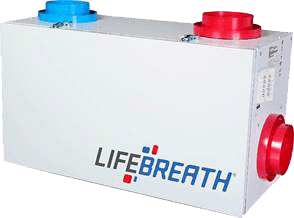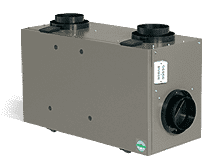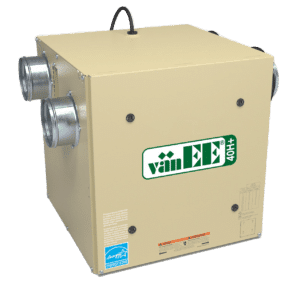What are HRVs ?
What is HRV?
A Heat Recovery Ventilator (HRV) is a mechanical ventilation system that enhances indoor air quality and energy efficiency in residential and commercial buildings. It operates by continuously exchanging stale, polluted indoor air with fresh outdoor air, ensuring a healthy indoor environment. During this exchange, the system uses a heat exchanger to recover a substantial portion of the heat from the outgoing air and transfer it to the incoming air. This process preheats the fresh air entering the building, reducing the load on the heating system and leading to significant energy savings, especially in cold climates.

The Basics of HRVs
A Heat Recovery Ventilator (HRV) is a balanced ventilation system that exchanges stale indoor air for fresh outdoor air while recovering heat (or cooling) from the outgoing air to pre-condition the incoming air. This reduces energy consumption for heating and cooling. HRVs work by passing exhaust air and fresh air over a heat exchanger, transferring heat (or cooling) between them without mixing the airstreams.
HRVs vs. ERVs. ?
The main difference between HRVs and ERVs is that HRVs transfer heat, while ERVs transfer both heat and moisture. This makes ERVs particularly useful in areas with high humidity levels, where reducing moisture is critical.


Why are HRVs important?
HRV systems are important because they enhance indoor air quality, reduce heating costs, and increase overall home comfort. They do this by exchanging stale indoor air with fresh, filtered air while recovering heat from the outgoing air, making them more energy-efficient than traditional ventilation. Improves indoor air quality by providing constant fresh air.
Saves energy by transferring heat between incoming and outgoing air.
Helps control indoor humidity levels.
Enhances overall comfort in living spaces.
Reduces heating and cooling costs.
How do HRVs work?
As said before, an HRV system is designed to supply conditioned air to an occupied space to reach a desired level of comfort. HRVs can be compared to noses on a building. This is because they consist of two ventilation ducts running next to one another passing between the inside and the outside of a building. One carries cool, fresh air in while the other carries moist, stale air out.
The hot, moist waste air from the building gives up almost all its heat as it passes through the heat exchanger on its way out of the building. The cold, dry incoming air flowing through the opposite duct picks this heat up as it flows into the building. Ideally, no heat is lost.
Choosing an HRV
When choosing an HRV there are several factors to consider, such as the size of the unit, the type of exchanger core, and the energy efficiency rating. A Home Comfort Advisor can help you determine which type of unit is best suited for your needs.
HRVs play a vital role in improving indoor air quality. By capturing heat and moisture from outgoing air and transferring it to incoming fresh air, these devices can help to remove pollutants, regulate indoor humidity levels, and potentially reduce energy costs. Consider investing in an HRV or ERV to help keep your indoor environment healthy and comfortable.
HRV Installation Services
System Assessment & Sizing
We evaluate your building’s layout, insulation level, and occupancy to recommend the right HRV model and ventilation capacity.Ductwork Planning & Integration
We design and install dedicated ducting or integrate the HRV with your existing HVAC system for balanced airflow.Unit Installation & Mounting
The HRV is installed in a centralized, accessible location (typically in a mechanical room or basement) and mounted securely with vibration-reducing hardware.Fresh Air & Exhaust Vents
Outdoor intake and exhaust vents are installed with weatherproofing and pest-resistant covers, following code requirements.System Calibration & Balancing
After installation, we fine-tune airflow, test efficiency, and balance the system to ensure even distribution of fresh air throughout your home.
HRV Repair & Diagnostics
Weak or No Airflow
We inspect filters, fans, and ductwork for blockages or mechanical issues that reduce ventilation performance.Frost Build-Up in Cold Weather
Faulty defrost controls or drain line clogs can cause internal freezing. We repair defrost timers, check heating elements, and clear drain systems.Unusual Noises or Vibrations
We examine fan motors, bearings, and mounts to fix rattling or buzzing sounds caused by wear or misalignment.Controls Not Responding
Whether wall-mounted controllers or digital interfaces, we troubleshoot communication issues, replace damaged wires, or update control boards.
HRV Replacement & Upgrades
If your system is outdated, underperforming, or no longer efficient, we offer full HRV replacement with modern, high-efficiency units. Benefits include:
Quieter operation
Improved air exchange rates
Smart controls and integration with HVAC systems
Preventive Maintenance Services
Regular maintenance extends the life of your HRV and ensures top performance:
Clean or replace filters every 3–6 months
Inspect and clean core heat exchanger
Check fan operation and airflow balance
Test drain lines and defrost mechanisms
Annual performance check by a certified technician
Why Choose an HRV?
Constant fresh air without drafts
Lower heating costs by recovering heat from outgoing air
Reduces indoor humidity, odors, and pollutants
Ideal for energy-efficient, airtight homes
FAQs
What are the benefits of installing an HRV in my home?
Installing an HRV can offer several key advantages. It helps maintain healthier indoor air by continuously supplying fresh air and removing pollutants, allergens, and excess humidity. Since it recycles heat from the outgoing air, it also helps reduce heating costs, making it an energy-saving solution. Additionally, by balancing humidity levels and preventing condensation, an HRV can reduce the likelihood of mold growth and improve overall comfort within your home.
Is an HRV suitable for all types of climates?
While HRVs are especially effective in cold climates where heating is needed for much of the year, their suitability can vary depending on where you live. In warmer, humid regions, an Energy Recovery Ventilator (ERV) might be more appropriate because it can transfer moisture as well as heat. The decision between an HRV and an ERV should be based on your local climate conditions and the specific needs of your household.
How often does an HRV need maintenance?
To keep an HRV functioning efficiently, regular maintenance is essential. Most systems require filter cleaning or replacement every three to six months. The heat exchanger core and the internal fans should also be inspected and cleaned periodically to prevent buildup of dust and debris. It’s generally recommended to have the entire system professionally serviced once a year to ensure it’s operating at peak performance and to extend the lifespan of the unit.
Testimonials
Honest Reviews from our Customers

Jane Anderson
Homeowner, San Diego
Ready to transform your outdoor space?
Contact us today to schedule a consultation or to learn more about our services.

